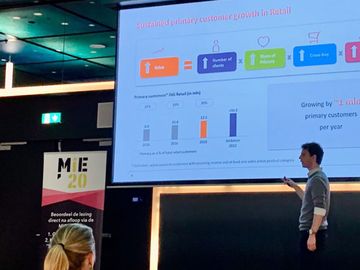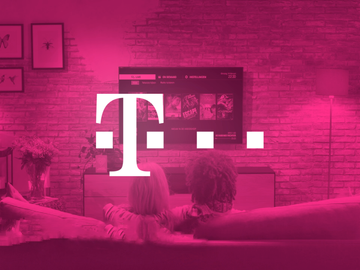
Peter Sonke (KPN): “I want the flows to be tight!”
KPN is the winner of the recent WUA! orientation study focused on taking out mobile phone contracts in The Netherlands (article in Dutch). The difference with Vodafone was 5 points, so a lot of things are going well at the Maanplein in The Hague. This interview is a conversation with Peter Sonke, who is responsible for online sales at KPN. About tight flows, feedback from the swimming pool, wanting to be the best, and binding and captivating digital talent.
Congratulations, Peter Sonke! You are the winner of this study of mobile contracts. How important is it for you to be the best with KPN?
“Of course we want to win these kinds of studies, and we are happy with our victory. KPN has the ambition to become the best service provider in the Netherlands, and to offer the very best buying experience. We’re not quite there yet, but every day we take a step towards achieving that goal!”
You don’t just score high on findability, but also the other topics of the WPS model. Your WPS score (78) is 6 points higher than that of the number 2 Vodafone (72). What is going so well for you?
“To be quite honest, I don’t think the flows of our competitors are necessarily worse than ours. I think that in addition to the big difference in findability, our high brand awareness makes all the difference. Incidentally, I do think that as a sector we need to change our sites from being product focused to being customer focused.” Sonke really aims to add a “Discovery layer” to KPN, much like Vodafone UK, with many attractive and moving images. Sonke: “Our industry is very product-driven, when in fact we should inspire consumers rather than bother them with specifications of octacore processors and monitors. The challenge will then be that the website should remain quick, and should be visible within 2-3 seconds, which is rather difficult if you’re using a lot of video. More experience = more content = longer loading time. That is demonstrably negative to the user experience.”
What is the role of customer research and customer focus in your daily work?
“We do a lot of customer research and we really measure everything. But I like to make a distinction between customer research we use to incrementally improve flows at kpn.com and research we use for development. For example, we use eyetracking to test new flows, and for every new environment a/b we test 3-4 variants, that’s just the basics with us. In addition, for the incremental part for example, we use the Usabilla feedback button.
“To us, NPS remains a very important part of customer feedback. We have noticed for example, that in the last mile of the sales process there is a lot your can do that could have a positive impact on the NPS. By adjusting packaging, or by offering Click & Collect for example, which I think is one of the best innovations in the area of customer satisfaction. Because a lot of people like to hold the device they are buying, they want to experience it. We have 115 KPN shops that allow people to leave the store with a working phone, and these stores can also be used to upsell. If a customer enters the shop to buy a phone, one of our people can inform them about KPN Complete. Through delivery by TNT or UPS you get a relatively cold experience in comparison.”
You’re in an extremely competitive field. How do you keep an eye on the competition?
“I will reveal that of course when we carry out usability research we also request a review of our competitors’ websites. We want to be the best service provider in the Netherlands, so therefore we specifically look at other industries and sectors. For example, if you look at apps, the banking sector is head of us at the moment. You try to improve by looking at the best elements of certain sectors.
“Every Sunday I spend two hours at the swimming pool with my children, and there I use my smartphone or tablet to look at all the sales flows I can find. Ours, but also those of our competitors. I noticed for example that Vodafone have a new flow for the de Galaxy S7, they’re doing something clever with number portability. It’s only a small example, but as you can see: I learn a lot from competitors. And yes, on those Sundays my team get a lot of e-mails from me, they’re not always happy with that.”
“We have an internal competition where teams have to go through the sales flows and if they encounter errors, they have to buy coffee for the other teams. And if they don’t find any errors, the other team has to get coffee. I want the flows to be tight!”
What is your biggest digital challenge?
“According to Sonke, the biggest challenge in digital isn’t technique, agile operation, or tooling – it’s people. And especially: digital people. “My biggest challenge is recruiting digital talent, keeping them, and captivating them. I already know that I shouldn’t offer large sums of money, but autonomy and responsibility. Digital natives want to decide how they organise their day, but at KPN autonomy also means that 28-year-olds can be responsible for significant revenue streams.”
“Also the role of data and the smart use thereof are competing for a top position on Sonke’s list of priorities. But he still has something to say about the role of creativity in relation to data. Sonke: “My most successful personalisation campaigns are the result of creativity. Data will be the main thing of course, but I think that creativity and UX are just as important as data. People also want to continue to be surprised, challenged, and sometimes overwhelmed. Personalisation based on data from the customer AND a perfect UX tailored to the customer, I believe in that combination. If I had to create a new website right now, I wouldn’t spend a lot of time kitting out a data warehouse, instead I would bet on really good personalisation, an extremely good UX, and content that is tailored to the needs of the customer.”
How do you view service in relation to sales? Could service eventually become the new sales in the telecom sector?
“I agree with that statement to a large extent. Very interesting. As mentioned, we focus very much on NPS, and we bring that idea into retail as well. Furthermore, it is of course true that good online service ultimately leads to customer satisfaction, and also to call reduction: therefore you could call good service cost efficient, in my eyes. It is also true that acquisition costs in telecom exceed retention costs, another very good reason for excellent customer service. Last point, and in my opinion the most interesting: I notice from the field that sales from a service environment and service idea is becoming more normal. We already have relevant offers in the app, and that works incredibly well. It may sound paradoxical, but receiving a sales offer you were not aware of that is tailored to your situation could very easily be experienced as good service.”


